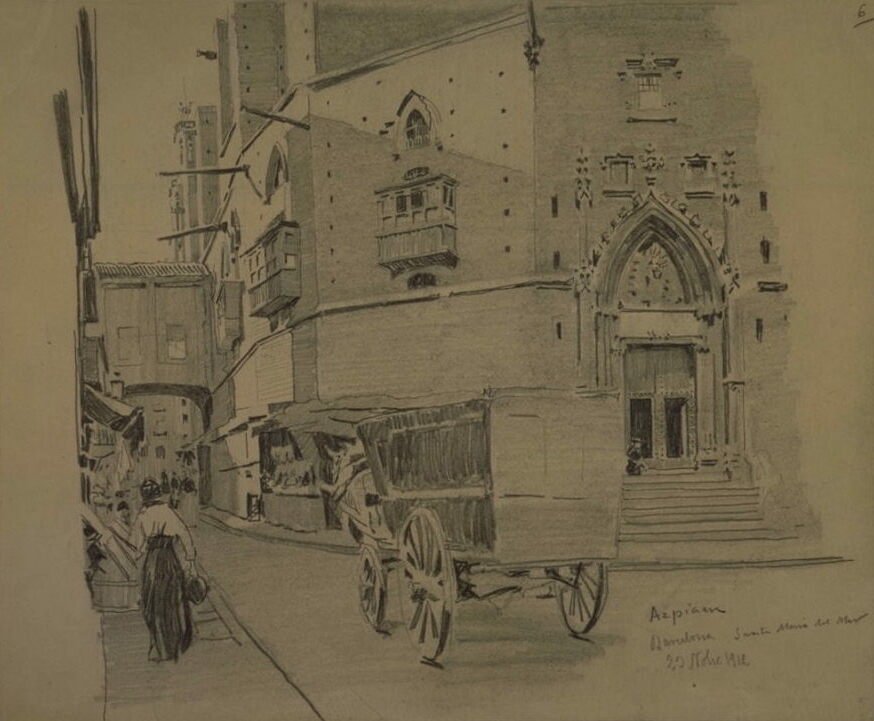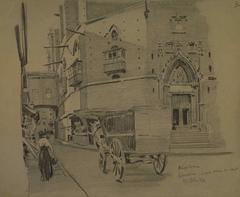
Santa Maria del Mar: Visiting Hours, Tickets, and History – A Comprehensive Guide to Barcelona’s Gothic Jewel
Date: 14/06/2025
Introduction
Santa Maria del Mar is one of Barcelona’s most treasured landmarks, embodying centuries of history, architectural mastery, and vibrant cultural significance. Nestled in the lively El Born district, this basilica is a quintessential example of Catalan Gothic architecture, admired for its soaring octagonal columns, harmonious three-nave layout, and stunning stained-glass windows—including the magnificent 15th-century rose window. Constructed rapidly between 1329 and 1384, its creation was a powerful community effort led by local merchants, shipbuilders, and porters known as the “bastaixos.” Unlike many grand cathedrals commissioned by royalty, Santa Maria del Mar is often called “the people’s cathedral,” reflecting its origins and ongoing cultural role.
Surviving fires, earthquakes, and the Spanish Civil War, the basilica has been meticulously restored, preserving its architectural purity and spiritual aura. Today, Santa Maria del Mar welcomes visitors daily to explore its serene interior, attend services, or join guided tours that reveal hidden gems such as the crypt and rooftop terraces. Its central location places it within walking distance of the Picasso Museum and the El Born Cultural Center, making it an essential stop for anyone interested in Barcelona’s heritage and architecture (Santa Maria del Mar Official Site; Barcelona Turisme; Spain.info).
Whether you are drawn by its historical significance, architectural elegance, or spiritual atmosphere, this guide provides everything you need to plan an enriching visit, including up-to-date information on visiting hours, tickets, accessibility, and travel tips.
Table of Contents
- Origins and Construction
- Architectural Features and Innovations
- Historical and Cultural Significance
- Visiting Hours, Tickets, and Accessibility
- Travel Tips and Nearby Attractions
- Visitor Experience and Atmosphere
- Preservation and Modern-Day Relevance
- Frequently Asked Questions (FAQ)
- Conclusion and Travel Resources
Origins and Construction
Santa Maria del Mar was built between 1329 and 1384, an unusually swift timeline for a medieval church. Its construction was spearheaded by the local merchant and shipbuilder community, who dedicated the church to the Virgin Mary, patroness of sailors and traders. Master builder Berenguer de Montagut, with the assistance of Ramon Despuig, supervised the project. The “bastaixos” played a crucial role, carrying stones from Montjuïc quarry by hand and boat, a testament to the collective determination of Barcelona’s working class (Santa Maria del Mar Official Site; History Tools).
Architectural Features and Innovations
Santa Maria del Mar is celebrated for its harmonious proportions and spatial clarity, hallmarks of Catalan Gothic architecture. The basilica’s interior features a vast nave 33 meters high and 13 meters wide, supported by slender octagonal columns spaced 13 meters apart. The absence of a transept and the use of large stained-glass windows—including the 15th-century rose window—create an uplifting space awash with colored light (Barcelona Turisme). The layout of three naves of equal height and only 16 supporting columns allows for uninterrupted openness and a striking sense of grandeur.
Though the exterior is relatively austere, it features two robust towers with octagonal spires and a pointed arch portal adorned with a tympanum of the Virgin Mary. The main doors display bronze reliefs of porters, commemorating the “bastaixos” (Barcelona Experience; Wikipedia). Noteworthy decorative elements include exquisite stained-glass windows depicting biblical scenes, local guild symbols, and a modern 1995 window featuring FC Barcelona’s crest (Barcelona Life).
Historical and Cultural Significance
Santa Maria del Mar stands as a symbol of Catalan identity and pride, built by and for the people of Barcelona—particularly the merchants, craftsmen, and porters of the Ribera district. It has served as a spiritual center for sailors, merchants, and artisans for centuries and hosts one of Barcelona’s oldest choral institutions, the Capella de Música de Santa Maria del Mar. The basilica’s depiction in Ildefonso Falcones’ “La Catedral del Mar” has drawn literary tourists and inspired a popular TV adaptation.
Throughout its history, Santa Maria del Mar has endured significant events, including the 1428 earthquake, a fire in 1379, and the Spanish Civil War, which destroyed much of its baroque interior. Community-backed restoration efforts have preserved its integrity and beauty (TripSavvy).
The basilica remains an active place of worship, offering daily Masses in Catalan and Spanish, as well as special liturgical celebrations during major festivals. Its open-door policy and affordable ticketing maintain its status as a “people’s church” (LocaBarcelona).
Visiting Hours, Tickets, and Accessibility
- Opening Hours: Typically, Santa Maria del Mar is open Monday to Saturday from 9:00 AM – 1:30 PM and 4:30 PM – 7:30 PM; Sundays and public holidays, 10:00 AM – 2:00 PM. Always check the official website for the most current schedule.
- Admission Fees: Entry to the main nave is generally free, especially during services. Tickets for guided tours (which may include access to the crypt and rooftop) cost around €5–€10, with discounts for students, seniors, and children. Barcelona residents and children under 16 often receive free entry.
- Ticket Purchase: Tickets can be bought online or at the entrance, but advance purchase is recommended during peak seasons (Ticketshop Barcelona).
- Accessibility: The basilica is wheelchair accessible, with ramps and adapted facilities. Assistance is available upon request.
- Language Support: Guided tours and information panels are available in English, Spanish, and Catalan.
Travel Tips and Nearby Attractions
- Best Times to Visit: Early mornings and late afternoons offer a quieter, more contemplative atmosphere. Weekdays are less crowded than weekends.
- Dress Code: As an active place of worship, modest attire is requested—shoulders and knees should be covered.
- Guided Tours: These provide deeper insight into the basilica’s history and architecture, including access to the crypt and rooftop terraces, which offer panoramic views of Barcelona (Things To Do in Barcelona).
- Concerts and Events: The basilica hosts regular concerts and cultural events; check the official schedule for details.
- Nearby Attractions: The El Born district is filled with medieval streets, artisan shops, cafes, and key sites like the Picasso Museum and the Barcelona History Museum (Spain.info).
Visitor Experience and Ambiance
Santa Maria del Mar’s interior is both majestic and intimate. Light streaming through stained-glass windows creates a kaleidoscope of colors, especially in the late afternoon. The restrained ornamentation highlights the purity of its Gothic lines, fostering a sense of calm and reflection. During religious services, the basilica resonates with choral music and organ, enhancing its spiritual ambiance.
Photography is permitted without flash, but visitors are asked to be respectful during services. The basilica is staffed by security personnel, and a small gift shop offers religious items and souvenirs.
Preservation and Modern-Day Relevance
Santa Maria del Mar is protected as a Bien de Interés Cultural by the Spanish government and benefits from ongoing preservation efforts. It remains an active parish church and a vibrant cultural venue, hosting religious services, concerts, and community events (History Hit). The church actively participates in sustainable tourism initiatives, encouraging visitors to respect the sacred space and local environment.
Frequently Asked Questions (FAQ)
Q: What are the basilica’s opening hours?
A: Typically Monday to Saturday, 9:00 AM – 1:30 PM and 4:30 PM – 7:30 PM; Sundays and holidays, 10:00 AM – 2:00 PM. Check the official website for updates.
Q: Is there an admission fee?
A: Entry to the main nave is free; tickets are required for guided tours, rooftop, and crypt access.
Q: Are guided tours available in English?
A: Yes, guided tours are offered in English, Spanish, and Catalan.
Q: Is Santa Maria del Mar wheelchair accessible?
A: Yes, with ramps and adapted facilities.
Q: Can I take photos inside?
A: Photography is allowed without flash; tripods and commercial photography require prior authorization.
Q: Can I attend religious services?
A: Yes, Masses and special liturgical events are open to the public.
Conclusion and Travel Resources
Santa Maria del Mar offers a captivating blend of history, architecture, and community spirit, making it an essential experience for any visitor to Barcelona. Plan your visit by consulting the official website for updated hours and ticketing. Consider booking guided tours in advance to access exclusive areas and make the most of your visit. Combine your trip with a stroll through the El Born district and other nearby attractions for a full immersion into Barcelona’s heritage.
For the latest updates, downloadable guides, and travel tips, download the Audiala app and follow us on social media.
References and Further Reading
- Santa Maria del Mar Official Site
- Barcelona Turisme
- Spain.info
- TripSavvy
- LocaBarcelona
- Ticketshop Barcelona
- Barcelona Experience
- History Tools
- Barcelona Life
- Things To Do in Barcelona
- History Hit
- Wikipedia






























































